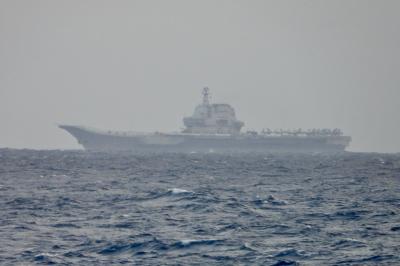The Ministry of National Defense’s annual National Defense Report, released yesterday, outlines the capability of domestic weapons, Taiwan’s increasing role in regional security and strategies for countering the continual threat of China’s military.
The main theme of the report is the military as a “defender of peace,” as it joins with Australia, Japan, South Korea, the Philippines, Singapore and Thailand in promoting the US’ Indo-Pacific strategy.
The nation’s indigenous defense industry has greatly evolved since President Tsai Ing-wen (蔡英文) took office, ministry spokesman Shih Shun-wen (史順文) told a news conference in Taipei.
The industry’s advancement has sustained existing projects and initiated new programs, including the manufacture of precision-fire missiles, unmanned aerial vehicles (UAVs), armored personnel carriers, Tuo Jiang-class guided-missile corvettes and submarines, the report said.
“The main military threat still comes from China, as its top leaders have not renounced the use of force to invade Taiwan, have spent a substantial portion of the national budget on increasing its military strength and moved to quickly modernize its armed forces. By trying to unilaterally alter the status quo across the Taiwan Strait, China poses the most serious challenge for Taiwan’s national security,” the report quoted Defense Policy Division Director Teng Keh-syong (鄧克雄) as saying.
Included in the report is a map showing the expanded range of China’s Dongfeng ballistic missiles. The earlier version could already reach Taiwan and most of Southeast Asia with its range of 1,000km.
The upgraded Dongfeng 10 and 21 has a range of 1,600km and can reach all of Japan, much of India and the Asia-Pacific region’s “second island chain.”
The ministry has a new telecommunications unit to combat fake news and misinformation regarding the military, Teng said, adding that through QR codes and the ministry’s Web sites, the unit can engage with the public and the media to rapidly correct false information.
The report was released with a summarized, comic book version that targets the younger generation so that the public can understand the nation’s defense programs and military strategies.
For the first time, the report presents new coastal defense plans to repel a force invading across the Taiwan Strait.
Previously, the military saw beaches as the focal point for repelling a potential invasion, but in 2017 that strategy was revised to include a broader perimeter, the report says.
Taiwan has been forced to shift its strategy as China has been developing expeditionary warfare and over-the-horizon amphibious assault capabilities that pose a threat all along Taiwan’s coastline, Teng said.
The report contains an illustration of how the military would repel an invasion of naval and aerial units, targeting a landing site along Taiwan’s coast.
It shows the nation’s larger warships and naval vessels being deployed along a perimeter in coastal areas as a first line of defense against possible invaders.
Behind those vessels, naval mines are used as a second line of defense, followed by Tuo Jiang-class corvettes and smaller naval vessels, while armored vehicles, tanks, multiple rocket launchers and other weapons systems are deployed on beaches.
It shows precision-fire missiles and military aircraft being used as further deterrence — all as part of the military’s “multiple deterrence” strategy adopted in 2017.
Additional reporting by CNA

US President Donald Trump yesterday announced sweeping "reciprocal tariffs" on US trading partners, including a 32 percent tax on goods from Taiwan that is set to take effect on Wednesday. At a Rose Garden event, Trump declared a 10 percent baseline tax on imports from all countries, with the White House saying it would take effect on Saturday. Countries with larger trade surpluses with the US would face higher duties beginning on Wednesday, including Taiwan (32 percent), China (34 percent), Japan (24 percent), South Korea (25 percent), Vietnam (46 percent) and Thailand (36 percent). Canada and Mexico, the two largest US trading

AIR SUPPORT: The Ministry of National Defense thanked the US for the delivery, adding that it was an indicator of the White House’s commitment to the Taiwan Relations Act Deputy Minister of National Defense Po Horng-huei (柏鴻輝) and Representative to the US Alexander Yui on Friday attended a delivery ceremony for the first of Taiwan’s long-awaited 66 F-16C/D Block 70 jets at a Lockheed Martin Corp factory in Greenville, South Carolina. “We are so proud to be the global home of the F-16 and to support Taiwan’s air defense capabilities,” US Representative William Timmons wrote on X, alongside a photograph of Taiwanese and US officials at the event. The F-16C/D Block 70 jets Taiwan ordered have the same capabilities as aircraft that had been upgraded to F-16Vs. The batch of Lockheed Martin

GRIDLOCK: The National Fire Agency’s Special Search and Rescue team is on standby to travel to the countries to help out with the rescue effort A powerful earthquake rocked Myanmar and neighboring Thailand yesterday, killing at least three people in Bangkok and burying dozens when a high-rise building under construction collapsed. Footage shared on social media from Myanmar’s second-largest city showed widespread destruction, raising fears that many were trapped under the rubble or killed. The magnitude 7.7 earthquake, with an epicenter near Mandalay in Myanmar, struck at midday and was followed by a strong magnitude 6.4 aftershock. The extent of death, injury and destruction — especially in Myanmar, which is embroiled in a civil war and where information is tightly controlled at the best of times —

China's military today said it began joint army, navy and rocket force exercises around Taiwan to "serve as a stern warning and powerful deterrent against Taiwanese independence," calling President William Lai (賴清德) a "parasite." The exercises come after Lai called Beijing a "foreign hostile force" last month. More than 10 Chinese military ships approached close to Taiwan's 24 nautical mile (44.4km) contiguous zone this morning and Taiwan sent its own warships to respond, two senior Taiwanese officials said. Taiwan has not yet detected any live fire by the Chinese military so far, one of the officials said. The drills took place after US Secretary